The Dash column explores art and its social contexts. The dash separates and the dash joins, it pauses and it moves along. The dash is where the viewer comes to terms with what they’ve seen. The galleries are closed, so Emma Kemp tuned in to Twitch, where artist Joshua Citarella shares his research tracking emerging political factions and the latest aberrations within online radicalization funnels.
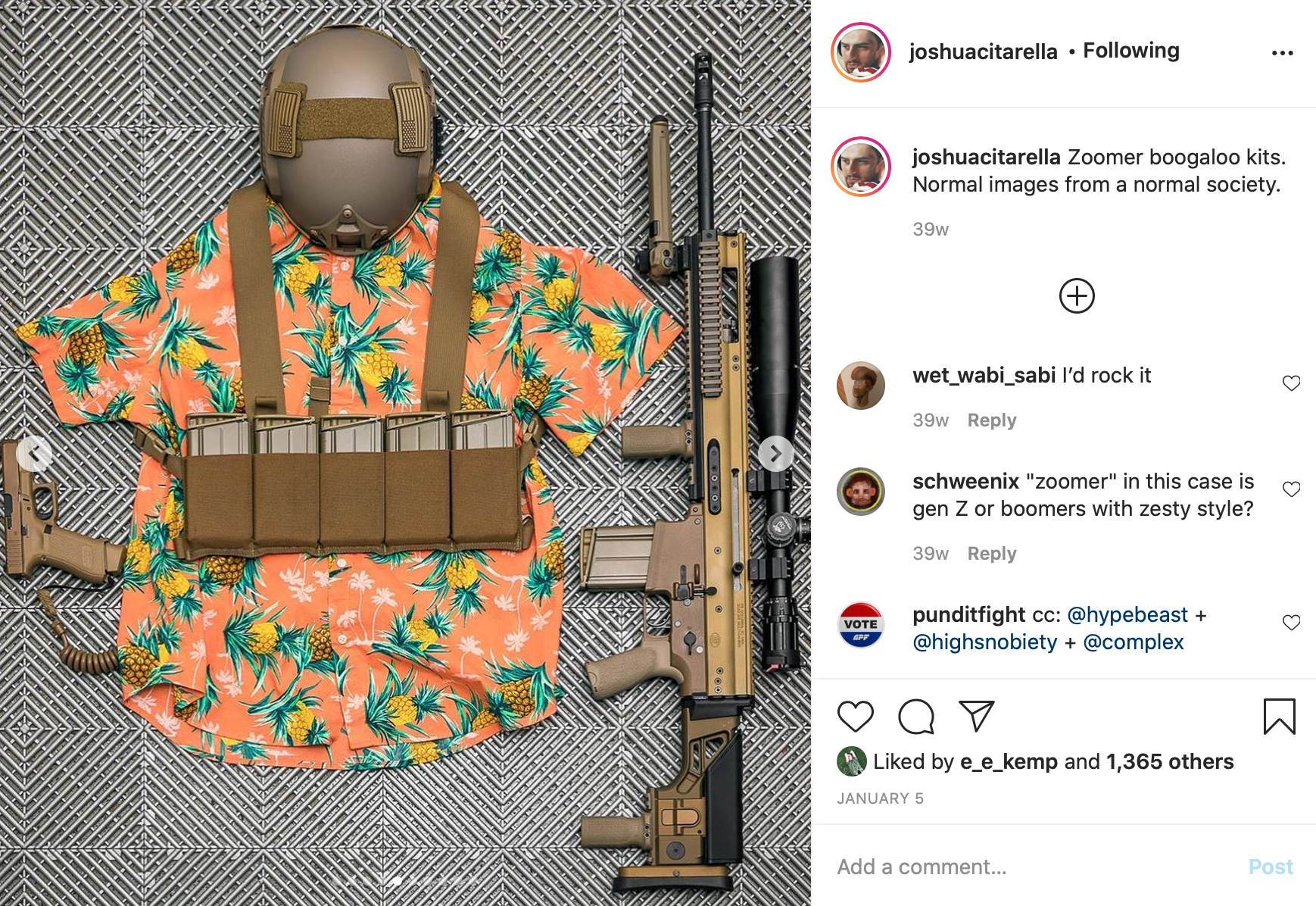
Joshua Citarella, Instagram post of found image depicting the unofficial uniform of the Boogaloo Bois, a Civil War nostalgia militia group comprised largely of white zoomer youth, January 5, 2020. Courtesy of the artist.
PEOPLE’S REPUBLIC OF TERRAFORMED AI PLANNING. PROBIOTIC UPSTATE DEGROWTH COMMUNE. FULLY LIQUID VOLUNTARIST CAYMEN ISLANDS. MICRODOSE THOUGHT LEADER PITCH SERMON.
These are a few of the possible futures referenced in Joshua Citarella’s Choose Your Future, a poster-sized C-print from early 2020 that documents nine speculative political-philosophies-cum-futurist-sects—or “e-deologies.” To the unacquainted, these strings of non sequiturs culled from the murky depths of Politigram (a portmanteau of “political” and “Instagram”) are mind-boggling. They read less like party identities than a Burroughs cut-up scrounged from Goop copy and IG wellness ads—word groupings that conflate millennial sloganeering with the clipped efficiency of the hashtag.
I’ll be honest: I’m seduced. Sometimes, when I’m arguing with my boyfriend in the kitchen of our Los Angeles shack, I stare him down and mouth “waifu holy war.” He backs off, a little threatened and a little thrilled by such disobedient language. The notion of disobedience here is crucial. In verbiage and thought, an ultra-niche ideological outpost like “citizen-orbitor roko fin-dom” is not just excessive but unruly, and therein resides its power. Like a strong meme, it has the potential to disrupt the façade of logical political discourse, aestheticizing and reproducing the conditions of its existence. Citarella has found himself poised as artist-scholar du jour of such Gen-Z vernacular. When scores of photogenic zoomers recently began sharing videos of themselves on TikTok, chewing blades of grass as they call for an atavistic turn to a deindustrialized era, Citarella identified the anarcho-primitivism (#AnPrim) resurgence as one of several esoteric political subgroups (#anarcho-Monarchism, #paleo-conservatism, #christprim, #post-civ, #eco-byzantium, #deepgreen) formed in the “post-left paradigm” of November 2016, when his new research interests began to crystalize.
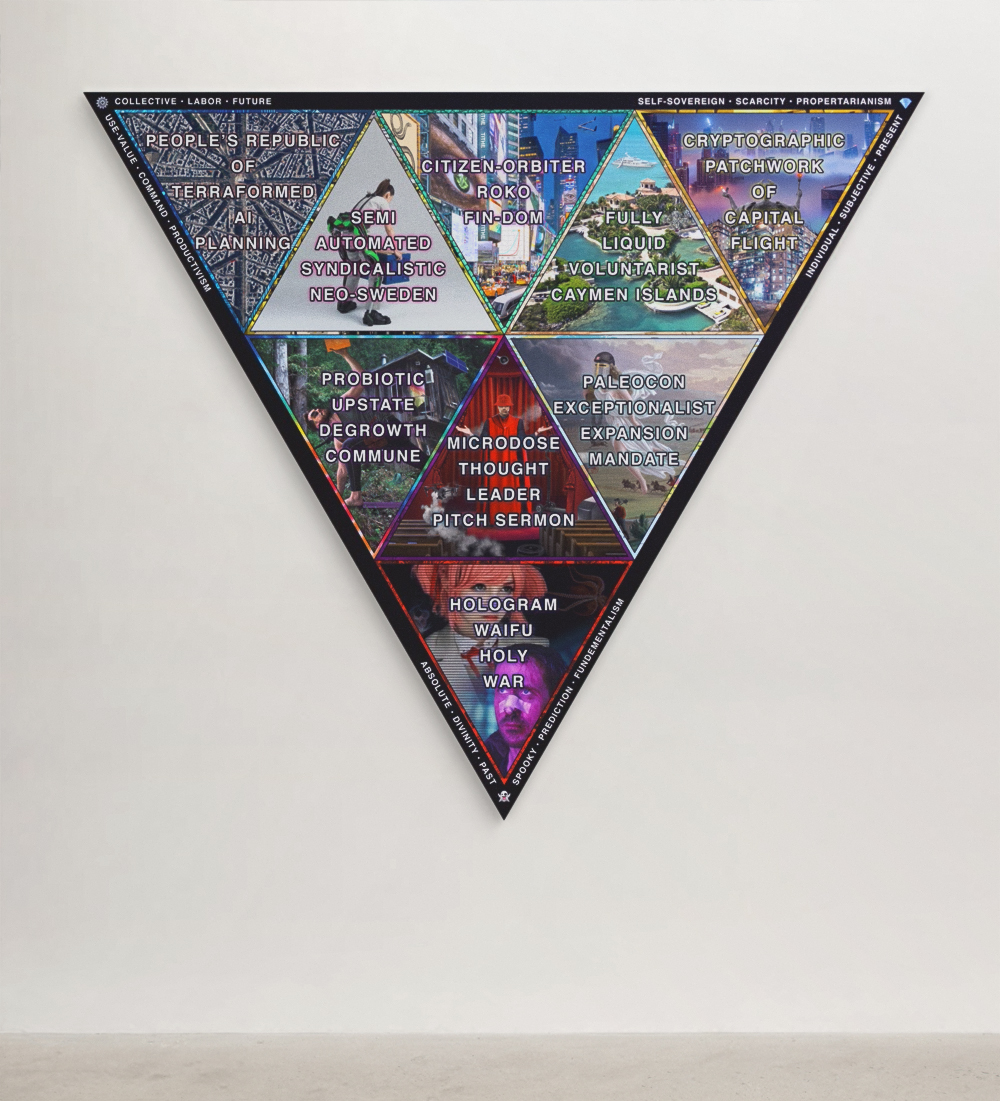
Joshua Citarella, Choose Your Future, 2020. C-prints on Dibond, 65 3/4 x 57 5/8 in. Courtesy of the artist. Photo: Joshua Citarella.
Citarella’s recent work overtly engages online politics, but he is no stranger to networked practice. His late-aughts contributions to viral Tumblr blog The Jogging are well documented, and he enjoyed early success among a roster of millennial artists using the internet to make work critical of—but nevertheless shaped by—the commercial gallery system. With Brad Troemel, Citarella founded UV Production House (UVPH) in 2016, an Etsy store of not-yet-ready-mades informed by long tail marketing nodes. Items like “floating pavilion for sinking Biennial cities” and “yarn bombed electric fence” are available for online purchase, upon which their constituent parts are sourced from decentralized manufacturing hubs to be assembled, Ikea-style, at the collector’s home. “It is as close to a debt-free artistic practice as possible,” Citarella said of the project at its inception. “It doesn’t require the artist to assume debt to produce the work, yet it’s still linked to objecthood.”
Objecthood has been an important, if cumbersome, element of Citarella’s engagement with artmaking. His large-format photo composites—300-layer dystopic environments with titles such as Genetically Modified Rose with Vacuum Bot and Sandy Footprints (2017) and Dried Goods with Solar Panel at Dawn (2017)—are immense fabrications requiring hours and hours of labor to produce something that can be exhibited and owned. As with UVPH, the work’s bite relies on a visible proximity to the art world infrastructure it finds absurd. Now, like the young people he tracks on social media, Citarella has shifted his practice to peripheral realms of production-circulation, circumventing the art world and its proprietary mechanisms. Rather than translating Web 2.0 vernacular for an elite audience, late 2020 finds Citarella forcefully engaged in an elsewhere practice broadcast via streaming hub Twitch and chat server Discord, platforms built to service gaming communities that have since been harnessed by artists, educators, and influencers alike.
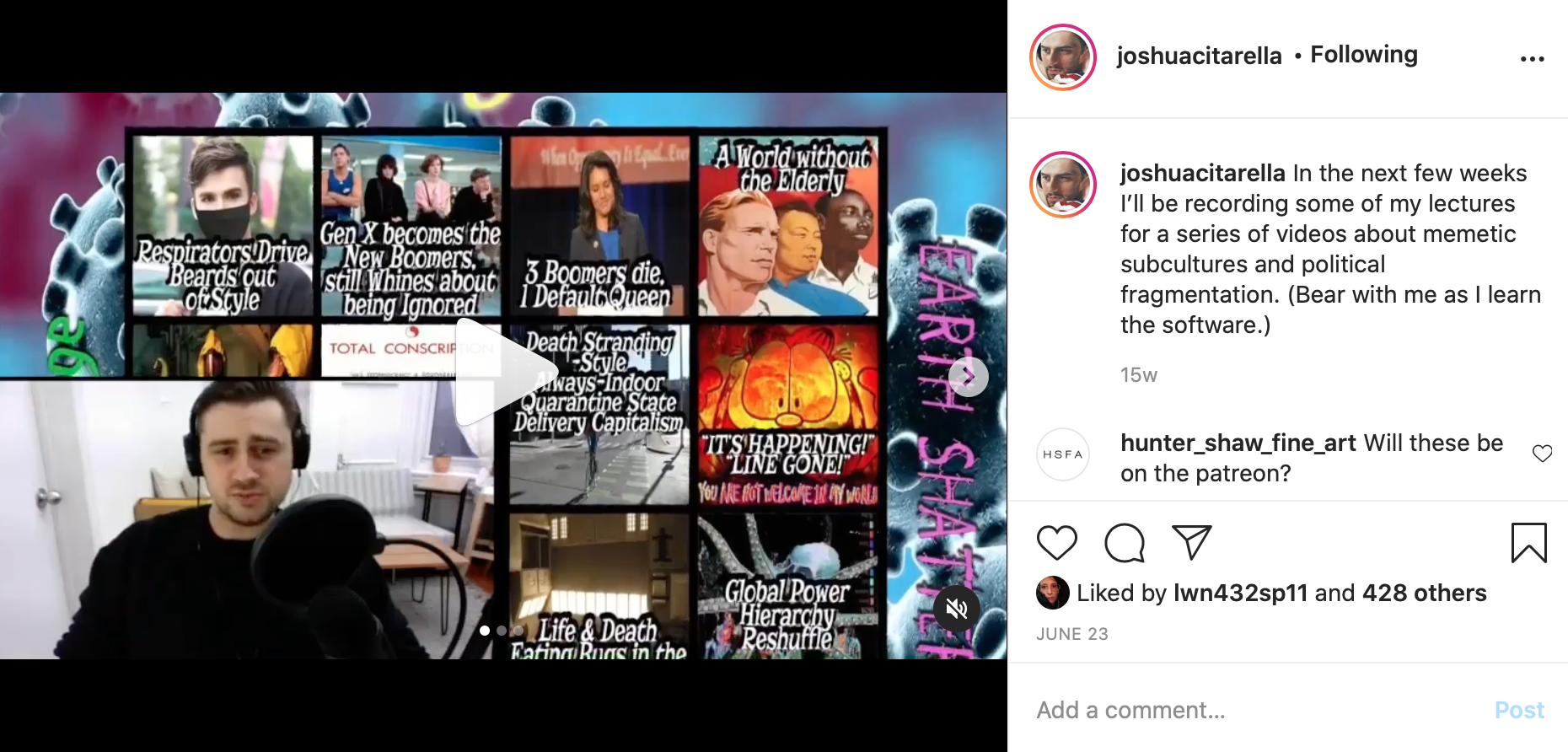
Joshua Citarella, Instagram post depicting a Twitch lecture, June 23, 2020. Courtesy of the artist.
To describe what Citarella does on Twitch and Discord is easy: he talks through his research on memetic subcultures. He gives lectures—but the fun kind, with intro beats and a raw chat log that shapes the conversation. Grouped under series titles like “Memes as Politics” and “Chart of Truth,” his streams run around fifty minutes and string together community hot takes, viral channel scraping, critical analysis of the day’s net conspiracies (“Q shit”), and deep dives into Bread Tube (a loose group of left-wing content creators named after the “Bread Book,” AKA Peter Kropotkin’s The Conquest of Bread). A series named “My Political Journey” features interviews with young, self-identified political extremists tracing the trajectory of their online radicalization. On “Josh’s Super Secret Sleeper Cell” Discord server, more than 300 users float between #left-watch, #lib-watch, and #right-watch, chatting and sharing resources like reading lists, PDF reserves, and syllabi. Like many of his peers, Citarella stores his content behind a Patreon paywall—a crowdsourced funding model that atomizes the singular philanthropist. At the time of writing, a modest 357 patrons support his practice at subscription tiers of $5, $15, or $40 per month. Still, he earns a higher wage livestreaming to this audience than he would teaching. This fall, he turned down an adjuncting gig at a prominent New York art school and made his syllabus for “Artists After the Internet” available to his patrons instead, reworked for distanced learning.
While it’s relatively easy to describe what Citarella does, it is decidedly more difficult to place it within legible categories of artistic production. Citarella’s livestream activity veers from entertainment to education to art. But this is not Beuys scrawling on a blackboard with a dead hare in his lap. Neither is Citarella particularly interested in activating a legible institutional critique à la Irit Rogoff and the 2008 “Educational Turn.” He is invested in his streams merely being what they are: critical online video content and material transfers for learning. The discursive modalities of Twitch and Discord produce remote pedagogical environments common to the post-COVID classroom. And, as AngieSpeaks and Contrapoints (Natalie Wynn) also demonstrate, the “influencer” content model is an undervalued form of political education. (Wynn’s video essays on issues triangulating culture, gender, and politics reach around one million subscribers.) Comparable artworld initiatives include Dark Study, a nascent online school founded by artist Caitlin Cherry in concert with Nicole Maloof and Nora Khan, self-described as “digitally-rooted and virtual-first” and promising a revolution in accessibility, radicality, and decoloniality in critical education. Dark Study is not a museum-funded participatory performance or a workshop on educational reform. Albeit “extra-territorial” and “parainstitutional,” it is simply school.
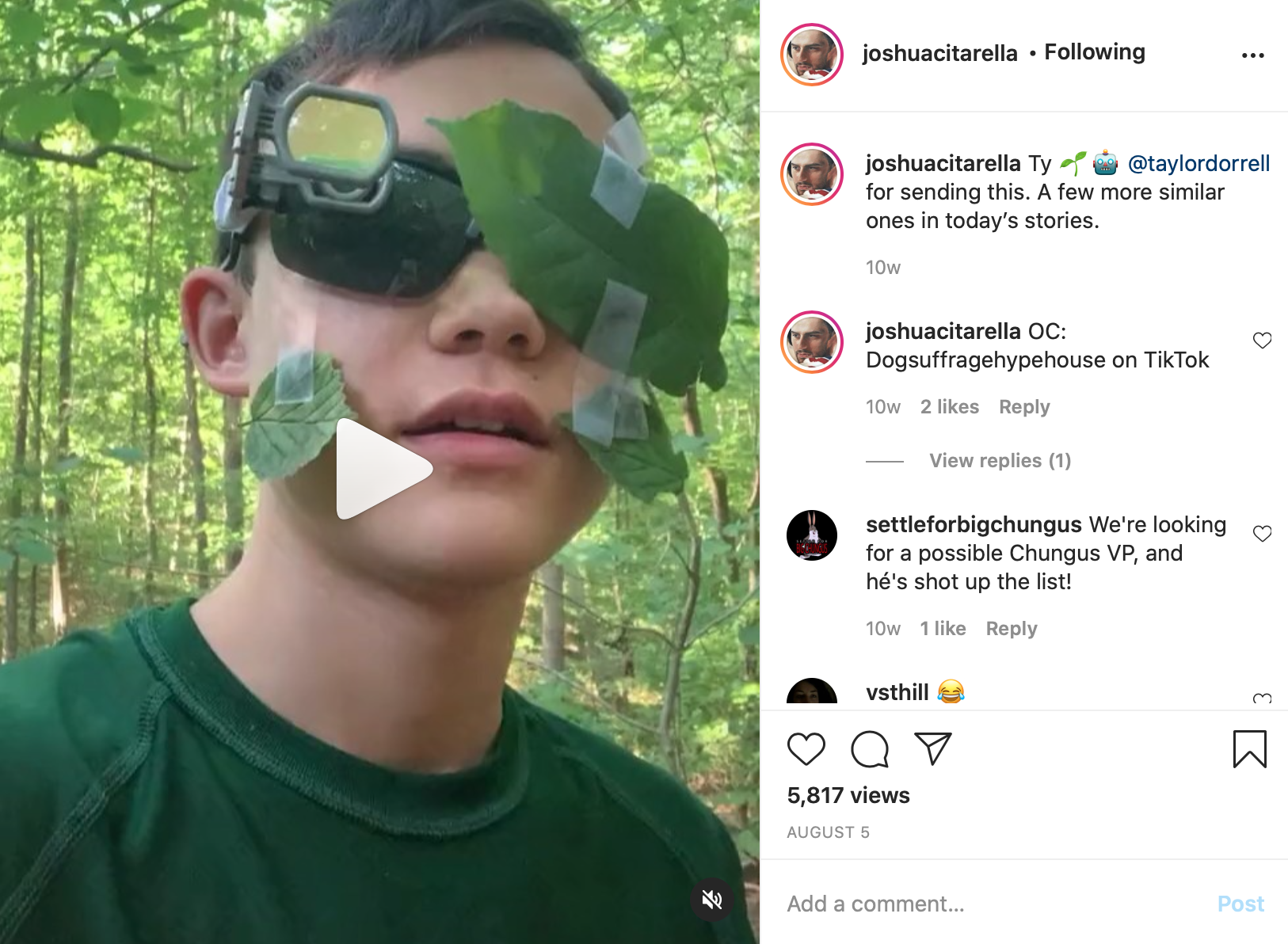
Joshua Citarella, Instagram post featuring #AnPrim TikTok video, August 5, 2020. Courtesy of the artist.
Likewise, Citarella defines his present activity not as art, per se, but as a kind of fieldwork for his art practice, which unfurls in the thickets of teenagers’ feeds. That he refuses to place his research and lectures in the conceptual category of art is crucial: it protects his efforts and, to a degree, the results, from artworld capture of the kind that leads to what theorist Stephen Wright calls “defanged representation”—symbolic gestures and tamed performances of agitation. Obviously, Citarella’s denial of his activity as art is only potent given the reasonable expectation, based on his history, that it might be. I suppose we could describe it as cultural investigation at the intersection of art, theory, and pedagogy, or as a research-based practice (😭), or simply as livestreaming. But the possibilities for artists and art to disrupt the status quo of our crisis-ridden present are made salient if we dare consider this labor, production, and community-making as art on a 1:1 scale.
Wright has coined an appropriately tricky term to refer to the kind of work I think Citarella is doing. He calls it “not not art,” or art with a “low coefficient of visibility” (after Duchamp), meaning “there’s no sure way of seeing it as art” according to present-day parameters. Wright frequently invokes Raivo Puusemp as an exemplar of 1:1 art-making. Puusemp’s practice pivoted around what he called “idea plants.” He would seed an idea for an artwork in another artist’s mind, and wait for the work to manifest. (According to him, it inevitably did.) Citarella revealed a similarly clandestine operation in his October 2020 podcast, “How to Plant a Meme,” where he offers a detailed account of how to covertly insert left-leaning content into anarchist ecosystems online with the intention of redirecting young people’s attention from extremist to center-left (which he finds to be the limit of such a pivot). Like Puusemp, Citarella has witnessed several of the memes he implanted in conservative channels almost a year ago crop up recently in his own left-leaning media pods. And, like Puusemp, Citarella withholds from this process the designation of art. Ashon Crawley, in his writings on “otherwise” relations in and around Black radical culture, introduces an adjacent notion: the otherwise as a “space and zone” from which alternative “modalities of living can emerge.” Between Wright’s “not not art” and Crawley’s “otherwise” modality, it becomes possible to situate Citarella’s activity in a space that produces new relations between users, producing useable knowledge beyond the merely symbolic.
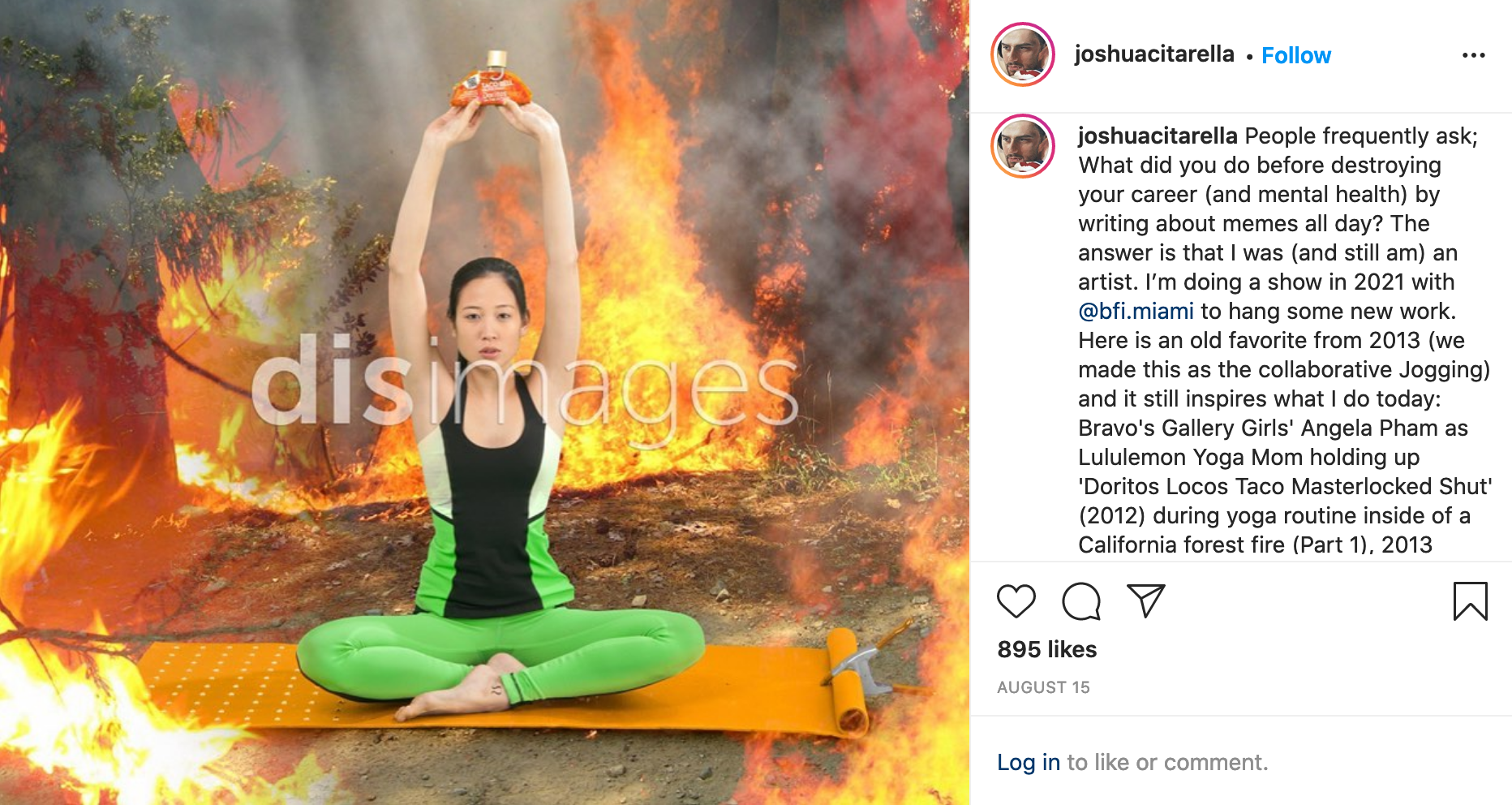
Joshua Citarella, Instagram post featuring Jogging, Bravo’s Gallery Girls’ Angela Pham as Lululemon Yoga Mom holding up ‘Doritos Locos Taco Masterlocked Shut’ (2012) during yoga routine inside of a California forest fire (Part 1), 2013, August 15, 2020. Courtesy of the artist.
In the wild, outside of the performative or symbolic relations so abundantly reproduced in/as/through the artworld, this “otherwise art” goes largely undetected. “Current events only register as ads,” mused Kaitlin Phillips in a recent column for Spike. “Grimes and Elon Musk’s baby is an ad for fan fic and birth control. Covid-19 is an ad for marxism and Central Europe. Quar is an ad for Apartamento and World of Interiors. Everything is a reminder we’re between revolutions.” I tried to fit art into this list, but I couldn’t come up with much, except that art is an advertisement for tax-free investment. Old but enduring news. “Should we abolish the fine art object to have it preserved as a meme?” Citarella pondered when I called him for background for this piece. “Preserve” is the sticky word here. What if we didn’t preserve the art object at all? Lots of my artist friends think I must hate art. I don’t. I just prefer it in drag. Reconstituted. Not not. x

Emma Kemp is a writer based in Los Angeles.